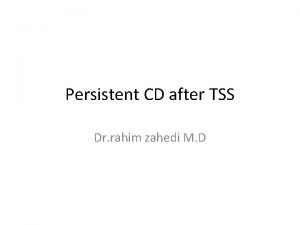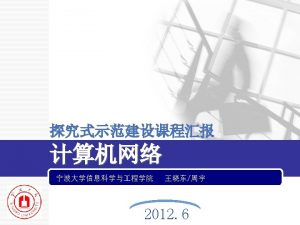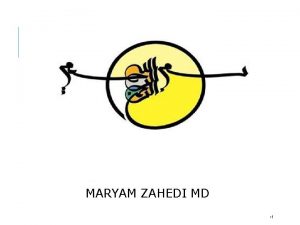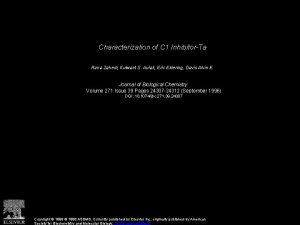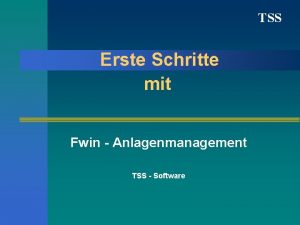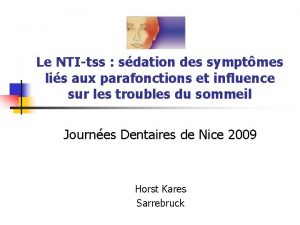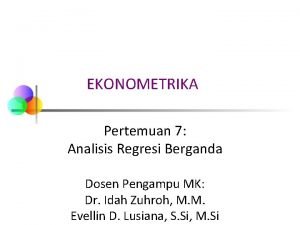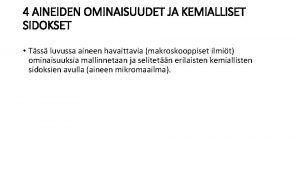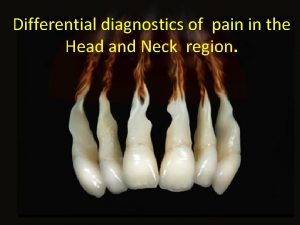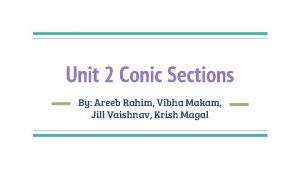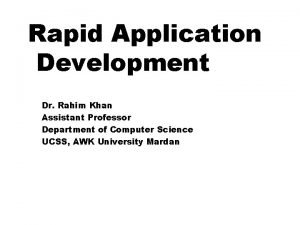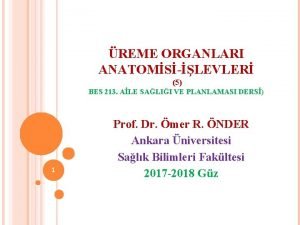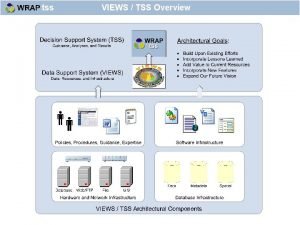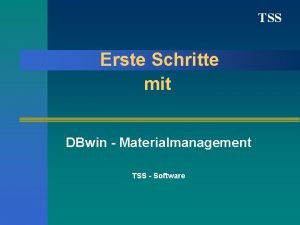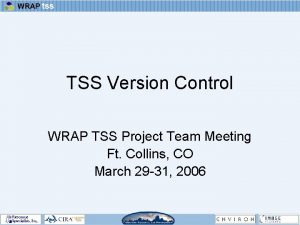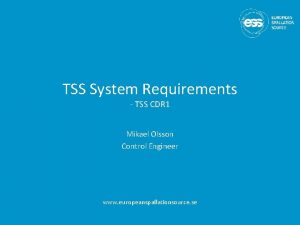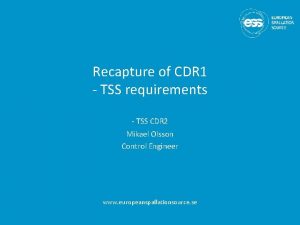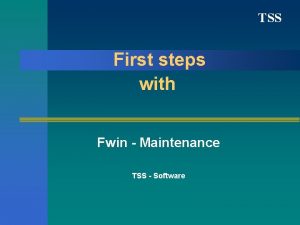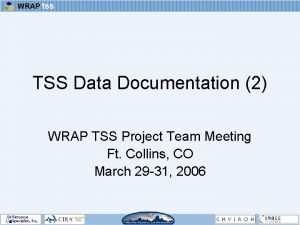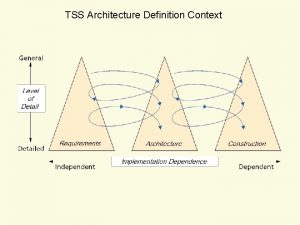Persistent CD after TSS Dr rahim zahedi M































- Slides: 31

Persistent CD after TSS Dr. rahim zahedi M. D

Problem list Before TSS : • • • weight gain Weakness menstrual abnormality easy bruising hirsutism depression After TSS : • • weight gain Weakness menstrual abnormality easy bruising hirsutism Depression DI


Postoperative initial remission • There is no consensus on the criteria for remission after resecting an ACTH-producing tumor • Normal corticotropes are suppressed by sustained hypercortisolism; therefore, ACTH and cortisol levels are low after resecting the ACTH-producing tumor • Remission is generally defined as morning serum cortisol values<5 mcg/d. L(<138 nmol/L) or UFC< 28– 56 nmol/d (<10– 20 mcg/d) within 7 days of selective tumor resection

• Adult series report a remission rate of 73– 76% for selectively resected microadenomas, but a lower remission rate for macroadenomas (43%) • The study also associated long term remission with younger age, smaller adenoma, and morning serum cortisol of <1 mcg /d. L • Patients with mild or cyclic CS and those rendered eucortisolemic by medical treatment before surgery may not have suppressed corticotropes • Their postoperative UFC and morning cortisol may be normal • In these patients, clinicians must measure late-night serum or salivary cortisol

• Patients who are eucortisolemic after resection, especially those with moderate preoperative hypercortisolism, may have residual tumors and are more prone to recurrence than patients with prolonged postoperative hypocortisolism • Early recovery (within 6 mo) of HPA axis function may indicate an increased risk of recurrence

Monitoring and treating Cushing’s features and comorbidities • Clinicians should tell patients that they may feel unwell for 6– 9 months, that their mood will gradually improve, and that improvement may continue for more than 1 year. Generally, weight, bruising, and the physical appearance of the face change first. • Patients should receive recommendations for physical therapy and nutrition to optimize the recovery of muscle strength and the normalization of weight.

Comparing of Remission VS Failure Remission • Salivary cortisol test • Overnight suppression test • NL rang UFC Failure • clinical condition was unchanged • morning serum cortisol values>5 mcg/d. L • UFC > 20 mcg/d • Not compatible of pathological result

• Between 1986 and 2002 179 patients underwent 185 IPSS procedures as part of their evaluation for Cushing’s syndrome. Six patients underwent two procedures






• IPSS is now considered to be a gold standard in the preoperative diagnosis of CD, with a diagnostic sensitivity of 95% and specificity of 90%- 95% • However, the of CRH had high cost limited its and use limitedavailability • Since the 1990 s, desmopressin (DDAVP) has been used as a substitute for CRH to stimulate adrenocorticotropic hormone (ACTH) secretion during IPSS

Procedure of IPSS • First, bilateral femoral veins were cannulated and catheters were guided into bilateral petrosal sinuses without anticoagulation • Next, peripheral venous blood from peripheral veins and the internal jugular veins as well as blood samples from left and right petrosal sinuses were collected and transferred to laboratory for ACTH assay • Then, 10 μg of desmopressin in saline solution was given intravenously. Peripheral blood samples and blood samples from bilateralpetrosal sinuses were collected 3, 5 and 10 minutes after the administration of desmopressin

Sensitivity and specificity • Among all 90 patients who had CD, 89 (98. 9%) had positive IPSS findings, therefore the sensitivity of IPSS in the diagnosis of CD was 98. 9% • The patient who did not have CD also had negative IPSS findings, therefore the specificity of IPSS in the diagnosis of CD was 100%.

Tumour lateralization accuracy In total, 37 (72. 5%) had IPSS lateralization in concordance with that of surgery, hence the concordance rate was 72. 5%.

• Of the 681 patients who had undergone transsphenoidal resection at Brigham and Women’s Hospital from April 2008 through April 2014, medical records were reviewed for 82 who had either CD or SCA.


Second-line therapeutic options • 6. 1 In patients with ACTH-dependent Cushing’s syndrome who underwent a non curative surgery or for whom surgery was not possible, we suggest a shared decision making approach because there are several available second-line therapies (eg, repeat trans sphenoidal surgery, radiotherapy, medical therapy, or bilateral adrenalectomy). (2++) • 6. 1 a We suggest bilateral adrenalectomy for occult or metastatic EAS or as a life-preserving emergency treatment in patients with very severe ACTH dependent disease who can not be promptly controlled by medical therapy. (2 +++) • 6. 2 Wesuggest repeat trans sphenoidal surgery, particularly in patients with evidence of incomplete resection, or a pituitary lesion on imaging. (2++)

• 6. 3 a. We suggest RT/radiosurgery in patients who have failed TSS or have recurrent CD. (2++) • 6. 3 b We recommend using RT where there are concerns about the mass effects or invasion associated with corticotroph adenomas. (1+++) • Although pituitary radiation may serve as a primary treatment for CD inindividuals who cannot undergosurgery or when the tumor is invasive or unresectable

Medical treatment

• 30 -year old female was referred to a specialized center for persistent hypercortisolism after pituitary surgery • One year ago she was diagnosed with Cushing’s disease after she had developed weight gain , high bloodpressure, mood change, fatigability, hirsutism, and amenorrhea. • The left part of the pituitary was preferentially removed, and pathological examination showed only normal intermingled pituitary cells that stained for all pituitary hormones.

• One week and 2 months after surgery, UC was essentially the same and was 2 to 3 times the upper limit of normal. The patient’s clinical condition was unchanged. • The BIPSS showed a clear central/peripheral gradient • Repeat MRI at 3 months, just before surgery, did not identify a clear image of adenoma. • Cautious surgery avoided bleeding such that adenomatous tissue was successfully visualized in the left part of the gland, allowing an apparently “complete removal. ” Pathology confirmed the corticotroph adenoma • Two weeks after surgery, both serum cortisol(less than 10 ng/ml) and ACTH (less than 5 pg/ml) were undetectable, with no response to desmopressin.

The patient had apparently jumped from track 2. . . To track 5

• After 3 years she presented with evidence of clinical recurrence (amenorrhea, weight gain), and unequivocal biological hypercortisolism. • The comparison of her pituitary MRI with that 3 months after the last surgery revealed evidence of new tissue growth in the left part of the sella, highly suggestive of an invasive adenomatous tissue remnant.

How to Choose? How to Evaluate? The Impossible Algorithm!


PLAN • wait and follow up • Medical treatment ( ketoconazole)

Thank you for your attention
 Rahim zahedi
Rahim zahedi Persistent vs non persistent http
Persistent vs non persistent http دکتر مریم زاهدی
دکتر مریم زاهدی Rana zahedi
Rana zahedi Zohreh zahedi
Zohreh zahedi After me after me after me
After me after me after me John 14 1
John 14 1 Fwin
Fwin Ibm tss services
Ibm tss services Ntitss
Ntitss Regresi
Regresi Tss luku
Tss luku Tss vs turbidity
Tss vs turbidity Nti tss
Nti tss Tss of heavy tomato puree
Tss of heavy tomato puree Tss met 40
Tss met 40 Abdul raheem wahab
Abdul raheem wahab Areeb rahim
Areeb rahim Dr rahim khan
Dr rahim khan Bismillahir rahmanir raheem
Bismillahir rahmanir raheem Wan abdul rahim kamil
Wan abdul rahim kamil 5. sınıf rahman ve rahim
5. sınıf rahman ve rahim Areeb rahim
Areeb rahim Gambar benjolan di leher rahim
Gambar benjolan di leher rahim Rahim kan
Rahim kan Wa innahu latanzilu rabbil alamin
Wa innahu latanzilu rabbil alamin Ur
Ur Minus desk in community medicine
Minus desk in community medicine Kadın anatomisi
Kadın anatomisi Er rahim
Er rahim Auzu billahi minash shaitanir rajeem meaning
Auzu billahi minash shaitanir rajeem meaning Bismillahir rahmanir rahim meaning in english
Bismillahir rahmanir rahim meaning in english
